IMF高级宏观经济学研修班课程CT1405MMF-L07Curren
- 格式:ppt
- 大小:334.43 KB
- 文档页数:51

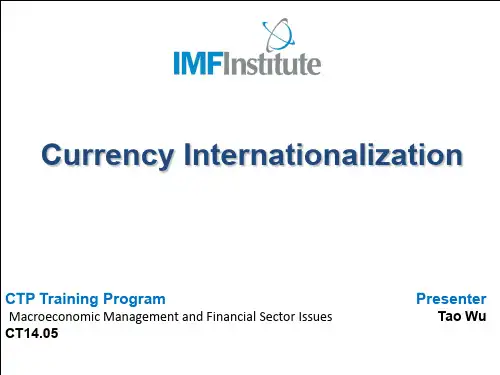

《高级宏观经济学》教学大纲(硕士研究生) - RonaldoCarpio《高级微观经济分析》教学大纲(博士研究生)课程代码:(按本专业或方向培养方案填写)课程名称:(按本专业或方向培养方案填写)英文名称:Advanced Microeconomic Analysis课程性质:(按本专业或方向培养方案填写)学分学时:3学分,48学时授课对象:金融学院一年级博士研究生课程简介:Based on Microeconomics I (for master students), the course will discuss thecontemporary development in microeconomics. This course is also designed to develop andextend the students’ analytical and reading skills in modern microeconomics. A student who haspassed the course should be able to read typical articles in the mainline journals, understand theanalytical derivations and arguments commonly used in the literature, and know how to solve themore widely used models.先修课程:Microeconomics for master students选用教材:1、 Mas-Colell, A., M. D. Whinston, and J. Green, Microeconomic Theory. (MWG)2、 Jehle, Geoffrey A. and Philip J. Reny, Advanced Microeconomic Theory. (JR)考核方式与成绩评定:Final Exam %; Midterm Exam %; Class Participation % 主讲教师:Carpio Ronaldo、颜建晔所属院系:金融学院联系方式:******************、*******************答疑时间及地点:求索楼123,Wednesday 13:30-14:30 (Carpio),Tuesday 15:00-17:00(颜)第一章:Consumer Theory教学目标和要求:Understand the consumer’s problem and consumer demand.教学时数:6学时教学方式:讲授准备知识:calculus教学内容:Preferences, Utility, and Consumer’s Problem第一节:Consumer’s Problem第二节:Indirect Utility, Demand作业与思考题:JR Ch 1.6参考资料:JR Ch 1, Appendix A1, A21第二章: Topics in Consumer Theory教学目标和要求:Understand duality, integrability, and uncertainty.教学时数:6 学时教学方式:讲授准备知识:statistics教学内容:Duality, Integrability, and Uncertainty 第一节:Duality of Consumer’s Problem第二节:Revealed Preferences & Uncertainty 作业与思考题:JR Ch 2.5 参考资料:JR Ch 2第三章: Theory of the Firm教学目标和要求:Understand the firm’s profit maximization problem.教学时数:6 学时教学方式:讲授准备知识:Chapter 1,2教学内容:Production, Cost, Profit Maximization 第一节:Production Functions & Cost第二节:Duality in Production, Competitive Firms 作业与思考题:JR Ch 3.6参考资料:JR Ch 3第四章: Partial Equilibrium教学目标和要求:Understand partial equilibrium markets. 教学时数:3学时教学方式:讲授准备知识:Chapter 3教学内容:Perfect & Imperfect Competition, Welfare 第一节:Competition 第二节:Equilibrium & Welfare作业与思考题:JR Ch 4.4参考资料:JR Ch 4第五章: Walras’/competitive equilibrium2教学目标和要求:competitive market economies from a Walrasian (general) equilibrium perspective.Let students understand “why the competitive market/equilibrium may work or fail?”教学时数:6学时方式:讲授教学准备知识:consumer theory, production theory教学内容:第一节:Walrasian economy and mathematical language of microeconomics 第二节:competitive equilibria of pure exchange and with production 作业与思考题:JR5.5, exercises of MWG Ch15, 18, 教师自编习题集参考资料:MWG Mathematical Appendix, Ch15, 18; JR5.4第六章: Social choice function/theory and social welfare: normative aspect of microeconomics教学目标和要求:When we judge some situation, such as a market equilibrium, as “good”or “bad”, or “better” or “worse” than another, we necessarily make at least implicit appeal to some underlying ethical standard. Welfare economics helps to inform the debate on social issues by forcingus to confront the ethical premises underlying our arguments as well as helping us to seetheir logical implications.Let students have a systematic framework for thinking about normative and social welfare topics.教学时数:3学时教学方式:讲授准备知识:Walrasian equilibrium教学内容:第一节:social choice, comparability, and some possibilities第二节:Rawlsian, Utiliterian, and flexible forms作业与思考题:JR6.5, exercises of MWG Ch21, 22, 教师自编习题集参考资料:MWG Ch21.A, Ch21.E, Ch22.C; JR Ch6第七章: Strategic Behavior and Asymmetric Information教学目标和要求:A central feature of contemporary microeconomicsafter Walrasian economy is the multi-agent interaction which represents the potential for the presence of strategicinterdependence. Let students grasp classic models of imperfect competition under symmetric and asymmetric information.3教学时数:3学时教学方式:讲授准备知识:perfect competition教学内容:第一节:monopoly and oligopoly under symmetric information第二节:oligopoly under asymmetric information作业与思考题:教师自编习题集参考资料:MWG Ch12; JR Ch4第八章: Theory of Incentives教学目标和要求:The strategic opportunities that arise in the presence of asymmetricinformation typically lead to inefficient market outcomes, a form of market failure. Underasymmetric information, the first welfare theorem no longer holds generally. Thus, the main themeto be explored is to stimulate different agents’ optimal/efficient behaviors in differentinformational settings to achieve the “second-best” market outcomes.教学时数:9学时教学方式:讲授准备知识:Strategic Behavior and Asymmetric Information教学内容:第一节:Adverse selection第二节:Moral hazard*第三节:Task separation/integration,第三节:Career concern作业与思考题:exercises of MWG Ch13, 14, 教师自编习题集参考资料:JR Ch8; MWG Ch13, 14第九章前沿研究讲座:待定邀请校外老师(待定)给学生们讲演最新研究,引导学生讨论;在学生掌握现代微观经济学基本模型之后能够接触到前沿研究。

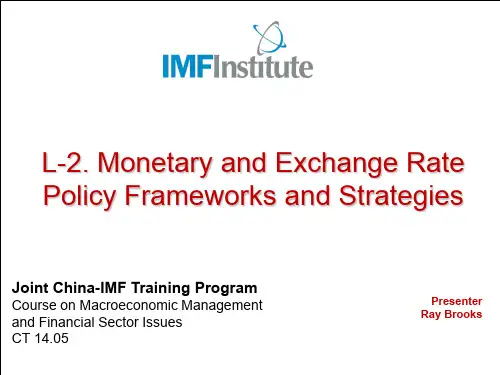
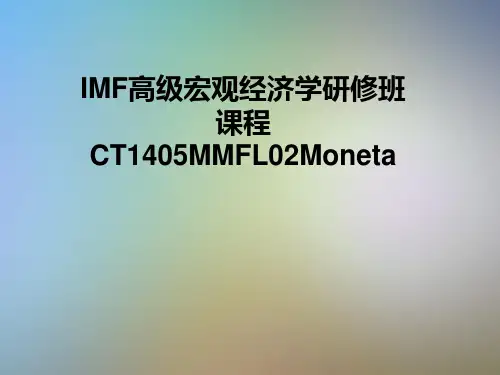
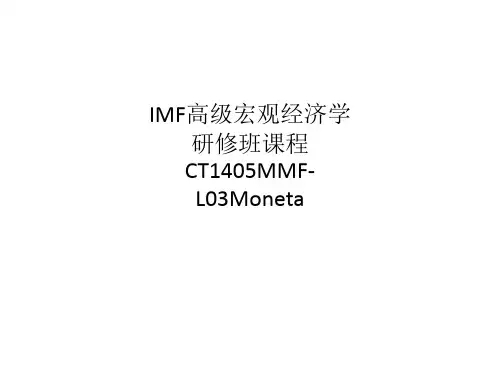
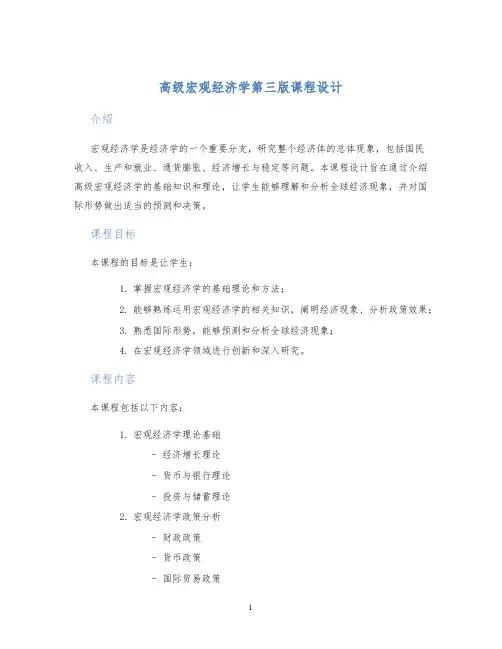
高级宏观经济学第三版课程设计介绍宏观经济学是经济学的一个重要分支,研究整个经济体的总体现象,包括国民收入、生产和就业、通货膨胀、经济增长与稳定等问题。
本课程设计旨在通过介绍高级宏观经济学的基础知识和理论,让学生能够理解和分析全球经济现象,并对国际形势做出适当的预测和决策。
课程目标本课程的目标是让学生:1.掌握宏观经济学的基础理论和方法;2.能够熟练运用宏观经济学的相关知识,阐明经济现象、分析政策效果;3.熟悉国际形势,能够预测和分析全球经济现象;4.在宏观经济学领域进行创新和深入研究。
课程内容本课程包括以下内容:1.宏观经济学理论基础–经济增长理论–货币与银行理论–投资与储蓄理论2.宏观经济学政策分析–财政政策–货币政策–国际贸易政策3.全球经济形势分析–全球经济动态与趋势–国际经济组织和规则–全球化与发展的挑战考核方式课程考核将采用多种方式,包括:1.课堂讨论与参与2.小组研究报告3.期末论文教学评估本课程采用评价体系,以提高教学的质量和学生的学习效果。
课程评估将参考以下因素:•学生的参与度•作业和考试成绩•学生对课程的学习反馈参考文献•Mankiw, N. Gregory. Macroeconomics. Worth Publishers, 2017.•Blanchard, Olivier. Macroeconomics. Prentice Hall, 2017.•Bernanke, Ben S., et al. Macroeconomics. McGraw-Hill Education, 2017.结语高级宏观经济学是一门综合性强、理论基础深厚、技能要求高的学科。
希望通过本课程的学习,能够掌握宏观经济学的基础理论和方法,熟悉国际形势,做到能够预测和分析全球经济现象,并在宏观经济学领域进行创新和深入研究。
若还有任何疑问,请随时与老师进行沟通交流。
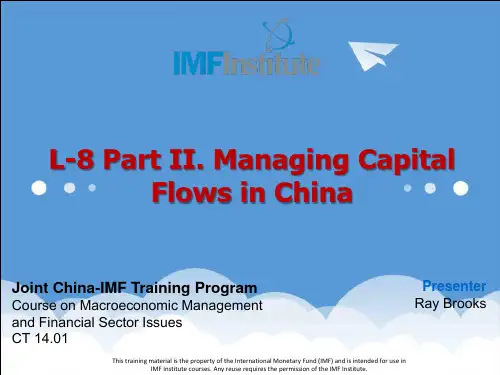
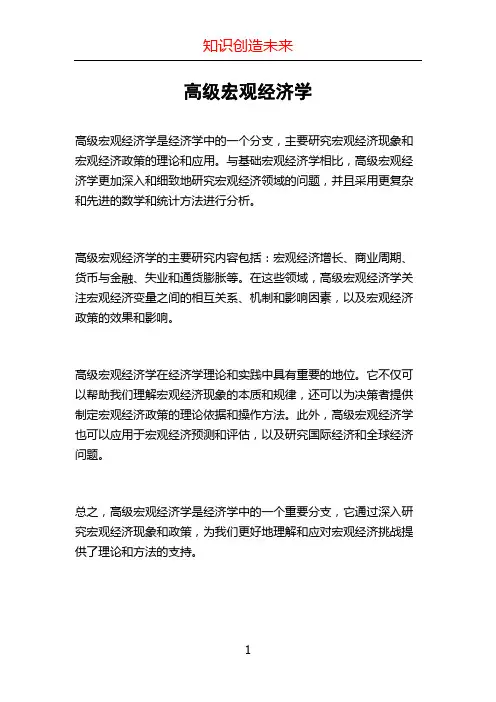
知识创造未来
高级宏观经济学
高级宏观经济学是经济学中的一个分支,主要研究宏观经济现象和宏观经济政策的理论和应用。
与基础宏观经济学相比,高级宏观经济学更加深入和细致地研究宏观经济领域的问题,并且采用更复杂和先进的数学和统计方法进行分析。
高级宏观经济学的主要研究内容包括:宏观经济增长、商业周期、货币与金融、失业和通货膨胀等。
在这些领域,高级宏观经济学关注宏观经济变量之间的相互关系、机制和影响因素,以及宏观经济政策的效果和影响。
高级宏观经济学在经济学理论和实践中具有重要的地位。
它不仅可以帮助我们理解宏观经济现象的本质和规律,还可以为决策者提供制定宏观经济政策的理论依据和操作方法。
此外,高级宏观经济学也可以应用于宏观经济预测和评估,以及研究国际经济和全球经济问题。
总之,高级宏观经济学是经济学中的一个重要分支,它通过深入研究宏观经济现象和政策,为我们更好地理解和应对宏观经济挑战提供了理论和方法的支持。
1。

《高级宏观经济学》课程教学大纲一、课程名称(中英文)中文名称:高级宏观经济学英文名称:Advanced Macroeconomics二、课程代码及性质学科(大类)基础课必修三、学时与学分总学时:64(理论学时:64学时;实践学时:0学时)学分:4四、先修课程先修课程:《经济学原理》,《中级微观经济学》,《中级宏观经济学》五、授课对象本课程面向经济学院经济学实验班以及启明学院经济学创新班专业学生开设六、课程教学目的(对学生知识、能力、素质培养的贡献和作用)本课程的教学目的,是介绍主流宏观经济学领域关于经济增长、经济波动、货币政策、财政政策及相关研究的文献和数理模型;培养学生使用数理经济学解释、分析经济现象的能力;提高经济实验班和经济创新班学生的逻辑思维能力,为其将来的研究生项目以及成为杰出的经济学家打好基础。
七、教学重点与难点:课程重点:长期经济增长理论与短期经济波动理论。
课程难点:课程中的数理经济模型较抽象,且个别部分需要用到研究生水平的数学工具。
八、教学方法与手段:教学方法:课堂讲授为主。
辅以中国经济热点问题专题讨论的环节。
教学手段:主要课程内容采用幻灯片演示的方法。
理论推导部分采用板书推导以及计算机仿真实验演示相结合的方式。
课程附带的论文复制任务,则在学院机房通过上机课的方式教授学生相应的软件知识。
九、教学内容与学时安排(一)教学内容1(教师课堂教学8学时+ 学生课后学习8学时)教学内容:索罗增长模型课后文献阅读:“The Solow Model with CES Technology: Nonlinearities and Parameter Heterogeneity”, Masanjala and Papageorgiou. Journal of Applied Econometrics. 19: 171-201 (2004).课后作业和讨论:课本第一章习题2,4,5,6。
(二)教学内容2(教师课堂教学8学时+ 学生课后学习8学时)教学内容:无限期限和重叠世代交替模型课后文献阅读:“Debts, Deficits, and Finite Horizons”, Blanchard, O.J., Journal of Political Economy 93: 223-247 (1985)课后作业和讨论:课本第二章习题2,4,8,14,18 (三)教学内容3(教师课堂教学12学时+ 学生课后学习12学时)教学内容:内生增长模型课后文献阅读:“Increasing Returns and Long Run Growth”,Romer, P.M., Journal of Political Economy 94: 1002-1037 (1986)课后作业和讨论:课本第三章习题1,6,11,14 四)教学内容4(教师课堂教学4学时+ 学生课后学习4学时)教学内容:跨国收入差距课后文献阅读:“Political Losers as a Barrier to Economic Development”, Acemoglu, D., Robinson, J.A., American Economic Review 90: 126-130 (2000)课后作业和讨论:课本第四章习题3,5,11五)教学内容5(教师课堂教学12学时+ 学生课后学习12学时)教学内容:真实商业周期理论课后文献阅读:“A Monetary History of the United States, 1867-1960”, Friedman, M., Schwartz, A.J., 1963, Princeton, NJ: Princeton University Press.课后作业和讨论:课本第五章习题2,5,8,12六)教学内容6(教师课堂教学8学时+ 学生课后学习8学时)教学内容:名义刚性课后文献阅读:“Expectations and the Neutrality of Money”, Lucas, R.E., Journal of Economic Theory 4: 103-124 (1972)课后作业和讨论:课本第六章习题2,4,7,11七)教学内容7(教师课堂教学8学时+ 学生课后学习8学时)教学内容:动态随机一般均衡模型课后文献阅读:“Limited Rationality and Strategic Complements: The Implications for Macroeconomics”, Haltiwanger, J., Waldman, M., Quarterly Journal of Economics 104: 463-483 (1989)课后作业和讨论:课本第七章习题1,4,8,10八)教学内容8(教师课堂教学4学时+ 学生课后学习4学时)教学内容:消费与投资理论专题课后文献阅读:无课后作业和讨论:课本第八章习题3,5,10;课本第九章习题1,3,5十、教学参考书及文献教学参考书:1、Advanced Macroeconomics (Fourth Edition),McGraw-Hill Irwin 出版,David Romer主编。
《高级宏观经济学专题》教学大纲本课程旨在引导学生跟踪现代宏观经济学研究的前沿,掌握宏观经济学研究的基本方法,尝试进行经济学研究并进行论文的写作。
宏观经济学研究的内容很多,我们这里选取其中比较重要的内容进行讨论。
主要包括:1.Ramsey 模型的推广1)Ramsey 模型中的时间偏好的改变;Uzawa‟s endogenous time preference function; Becker-Mulligan‟s time preference generation function; Marshallian‟s time preference generation function; Laibson‟s time preference function; Zou‟s endogenous time preference function.2) 效用函数的改变:Leisure in Ramsey Model; Bonds in the Ramsey modelSocial status in Ramsey modelHabit formation in Ramsey modelCatch up with Joneses in Ramsey ModelMoney in the Ramsey modelOthers:Wealth lose in the Ramsey modelAnxiety in Ramsey modelPower in Ramsey modelPollution in Ramsey modelMilitary Spending in Ramsey ModelHealth in Ramsey ModelHousing capital in Ramsey model3) 开放经济的Ramsey 模型4) Ramsey model with finite horizon;2. Ramsey 模型的应用:1) Ramsey 模型中的政府花费和税收;Turnovsky‟s welfare analysis method;Judd‟s welfare analysis method;Chamley‟s welfare analysis method et al.2) 货币理论与货币政策基本模型:T oin模型;Sidrauski模型;S tockman模型;Inflation and welfare costLucas, R. Jr, Infaltion and welfare cost, Econometrica, 2000(3).Gong Liutang, 2001, Money, social status, and welfare cost in a model with cash-in-advance model, Mimeo, Peking University and Wuhan University.3.内生经济增长模型:1)AK模型;2)两部门的内生经济增长模型;3)内生经济增长模型中的不确定性;Benhabib J. and J. Gali,1995, On growth and indeterminacy: Some theory and evidence. Mimeo, New Y ork University.Benhabib J. and R. Perli, 1994, Uniqueness and indeterminacy: Transitional dynamics in a model of endogenous growth. Journal of Economic Theory, 63:113-142.Xie Danyang, 1994. Divergence in economic performance: Transitional dynamics with multiple equilibria. Journal of Economic Theory 63:97-112.Sergey Slobodyan, 2007, Indeterminacy and stability in a modified Romer model. Journal of Macroeconomics V olume 29, Issue 1, March 2007, Pages 169-177Alfred Greiner and Willi Semmler, 1996, Multiple steady states, indeterminacy, and cycles in a basic model of endogenous growth. Journal of Economics 63,77-99.Mulligan C. B. and X. Sala-I-Martin, 1993. Transtional dynamics in two-sector models of endogenous growth. Journal of Political Economy August:739-773.4) Government expenditure in a edogenous growth modelBarro, R.J., 1990, Government spending in a simple model of endogenous growth. Journal of Political Economy, 98: S103-S125.Lucas, R. Jr, 1993. Making a miracle. Econometrica 61(2)251-272.Lucas, R. Jr., 1988. On the mechanics of economic development. Journal of Monetray Economics 22:3-42.Romer, P. M., 1990. Endogenous technological change. Journal of Political Economy 98:S71-S102.Rebelo, S., 1991, Long-run policy analysis and long-run growth. Journal of Political Economy, 99: 500-521.Ortigueira S. and M., Santos, 1997. On the speed of convergence in endogenous growth model. American Economic Review June:383-399.Structural Change and Economic GrowthKongsamut Piyabha, Sergio Rebelo and D. Xie, “Beyond Balanced Growth,” Review of Economic Studies, V ol. 68, November, 2001: 869-882.Ngai Rachel and Christopher Pissarides, “Structural Change in a Multi-Sector Model of Growth,” London School of Economics, Mimeo, 2006.Acemoglu Daron and V eronica Guerrieri, “Capital Deepening and Non-Balanced Economic Growth,” Manuscript, 2006.内生增长模型的福利分析Ortigueira S (1998,JME)Other endogenous growth modelsEndogenous growth model with health input;Endogenous growth model with pollution;Endogenous growth model with power;Endogenous growth with military spendingEndogenous growth with habit formation4.随机增长模型:1)随机Ramsey 模型;2)Turnovsky方法;3)随机货币模型;4)Non-expected utility function and stochastic growth5)Habit formation and economic growth6) Recursive preference and economic growthBakshi, G. S., and Chen, Z. (1996). The spirit of capitalism and stock-market prices, The American Economic Review 86: 133-157.Eaton J. (1981). Fiscal policy, inflation, and the accumulation of risk capital, Review of Economic Studies 48: 435-445.Fischer, S. (1975). The demand for index bonds. Journal of Political Economy 83: 509-534.Gong Liutang. (2003) Stochastic growth in a production economies with the spirit of capitalism. Mimeo. Peking University.Gong Liutang. (2003) Fiscal Policies in a Stochastic Model with Hyperbolic Discounting. Mimeo. Peking University.Gong, Liutang and Heng-fu Zou (2002). Direct wealth effects, fiscal policies, asset pricing, and stochastic growth. Journal of Economic Dynamics and Control 26(2), 243-270 Gong, Liutang and Heng-fu Zou (2002). Military spending and stochastic growth. Journal of Economic Dynamics and Control.Grinols, E. and S. Turnovsky (1998). Risk, optimal government finance and monetary policies in a growth economy. Economica 65,401-427.Merton R.C.(1971) Optimal consumption and portfolio rules in a continuous-time model, Journal of Economic Theory 3: 373-413.Obstfeld, M.(1994). Risk-taking, global diversification, and growth. The American Economic Review 84: 1310-29.Turnovsky, S. (1995). Methods of Macroeconomic Dynamics. MIT Press.Growth with incomplete marketAiyagari, S. Rao, 1994, “Uninsured Idiosyncratic Risk and Aggregate Saving”, Quarterly Journal of Economics, 109: pp. 659-684.Benhabibi J. and Shenghao Zhu, "Age, Luck, and Inheritance" (with Shenghao Zhu), November 2007Golosov, M., and R. Lucas. "Menu Costs and Phillips Curves." NBER working paper #10187, December 2003.5.RBC模型Fiscal policy and monetary policy in RBC modelChina economy in a RBC model6.Income distributionAghion, P. (2002). Schumpeterian growth theory and the dynamics of income inequality. Econometrica 70(3),855-882.Aghion, P. and Bolton, P. (1997). …A theory of trickle-down growth and development.‟ Review of Economic Studies, vol.64, pp151-172.Alesina, A. and D.Rodrik (1994). …Distributive politics and economic growth.‟ Quarterly Journal of Economics, vol. 109, no. 2 (May), pp.465-90.Benhabib, J."Dynamic Economic Equilibrium under Redistribution," Journal of Difference Equations and Applications, 13,2007, 107-120.Banerjee, A.V. and Newman, A.F. (1993). …Occupational ch oice and the process of development.‟ Journal of Political Economy, 101, pp274-298.Cripps M. (1999). Capital market risk and the dynamics of the income distribution. CSGR Working Paer.Eeckhout J. and B. Jovanovic (2002) Knowledge Spillovers and Inequality. The American Economic Review 92(5), 1290-1307.Galor, O. and Zeira, J. (1993). …Income distribution and macroeconomics.‟ Review of Economic Studies, vol. 60, no. 1 (January), pp. 35-52.Greenwood, J. and Jovanovic, B. (1990). …Financial development, growth, and the distribution of income.‟ Journal of Political Economy, vol. 98, no. 5 (October), pp.1076-107.Gong Liutang and Heng-fu Zou (2001). …Comments on the paper …Dynamics of income distribution‟‟. Mimeo. Peking University and Wuhan University.Hongyi Li, Danyang Xie, and Heng-fu Zou (2000). …Dynamics of income distribution.‟ Canadian Journal of Economics, vol.33, No.4 pp937-961.Hongyi Li and Heng-fu Zou (1998). …Income inequality is not harmful for growth: Theory and evidence.‟ Review of Development Economics, 2(3), pp.318-34.Kuznets, Simon. (1955). …Economic growth and income inequality.‟ American Economic Review, XLV, PP1-28.Lucas, R.E. (1992). …On efficiency and distribution‟. The Economic Journal, vol.102, no.411 (March), pp.233-247.Matsuyama, Kiminori (2000). …Endogenous inequality‟. Review of Economic Studies, vo l.67, and pp743-759.Persson, T. and G.Tabellini (1994). …Is inequality harmful for growth?‟ American Economic Review, vol. 84, no.3 (June), pp.600-21.Piketty, T. (1997). …The dynamics of the wealth distribution and the interest rate with credit rationing.‟ Review of Economic Studies, vol.64, and pp.173-189.7.Price determinacy and fiscal policy8. Robust (ambiguity) and growth。